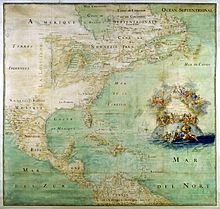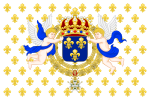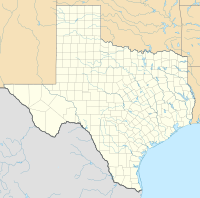French colonization of Texas
| History of Texas | ||||||||||||||||||
|---|---|---|---|---|---|---|---|---|---|---|---|---|---|---|---|---|---|---|
 | ||||||||||||||||||
| Timeline | ||||||||||||||||||
|
||||||||||||||||||
|
| ||||||||||||||||||
The French colonization of Texas began with the establishment of a fort in present-day southeastern Texas. Fort Saint Louis was established in 1685 near Arenosa Creek and Matagorda Bay by explorer Robert Cavelier de La Salle. He intended to found the colony at the mouth of the Mississippi River, but inaccurate maps and navigational errors caused his ships to anchor instead 400 miles (640 km) to the west, off the coast of Texas. The colony survived until 1688. The present-day town of Inez is near the fort's site. The colony faced numerous difficulties during its brief existence, including Native American raids, epidemics, and harsh conditions. From that base, La Salle led several expeditions to find the Mississippi River. These did not succeed, but La Salle did explore much of the Rio Grande and parts of east Texas.
During one of his absences in 1686, the colony's last ship was wrecked, leaving the colonists unable to obtain resources from the French colonies of the
Spain learned of La Salle's mission in 1686. Concerned that the French colony could threaten Spain's control over the
La Salle expeditions
First expedition

By the late 17th century, much of North America had been claimed by European countries. Spain had claimed
Unless France established a base at the mouth of the Mississippi, Spain would have an opportunity to control the entire Gulf of Mexico and potentially pose a threat to New France's southern borders.[4] La Salle believed that the Mississippi River was near the eastern edge of New Spain. On his return to France in 1684, he proposed to the Crown the establishment of a colony at the mouth of the river. The colony could provide a base for promoting Christianity among the native peoples as well as a convenient location for attacking the Spanish province of Nueva Vizcaya and gaining control of its lucrative silver mines.[2][5] He argued that a small number of Frenchmen could successfully invade New Spain by allying themselves with some of the more than 15,000 Native Americans who were angry over Spanish enslavement.[2] After Spain declared war on France in October 1687, King Louis agreed to support La Salle's plan.[2] He was to return to North America and confirm "the Indians' allegiance to the crown, leading them to the true faith, and maintaining intertribal peace".[5]
Second expedition
La Salle originally planned to sail to New France, journey overland to the south and Illinois Country, and then travel down the Mississippi River to its mouth.
The ships carried a total of nearly 300 people, including soldiers, artisans and craftsmen, six Catholic missionaries, eight merchants, and over a dozen women and children.
During the 58-day voyage, two people died of illness and one woman gave birth to a child.[12] The voyage to Saint-Domingue had lasted longer than expected, and provisions ran low, especially after the loss of the St. François. La Salle had little money with which to replenish supplies, and finally two of the merchants aboard the expedition sold some of their trade goods to the islanders, and lent their profits to La Salle. To fill the gaps left after several men deserted, La Salle recruited a few islanders to join the expedition.[14]
In late November 1684, when La Salle had fully recovered from a severe illness, the three remaining ships continued their search for the Mississippi River delta.[13] Before they left Santo Domingo, local sailors warned that strong Gulf currents flowed east and would tug the ships toward the Florida straits unless they corrected for it.[15] On December 18, the ships reached the Gulf of Mexico and entered waters that Spain claimed as its territory.[16] None of the members of the expedition had ever been in the Gulf of Mexico or knew how to navigate it.[17] Due to a combination of inaccurate maps, La Salle's previous miscalculation of the latitude of the mouth of the Mississippi River, and overcorrection for the currents, the expedition failed to find the Mississippi.[15] Instead, they landed at Matagorda Bay in early 1685, 400 miles (640 km) west of the Mississippi.[15]
First settlement

On February 20, the colonists set foot on land for the first time in three months since leaving Saint-Domingue. They set up a temporary camp near the site of the present-day
Against Beaujeu's advice, La Salle ordered La Belle and the Aimable "to negotiate the narrow and shallow pass" to bring the supplies closer to the campsite.
For several days the men attempted to salvage the tools and provisions that had been loaded on the Aimable, but a bad storm prevented them from recovering more than food, cannons, powder, and a small amount of the merchandise. The ship sank on March 7.[20] The French watched the Karankawa loot the wreckage. As French soldiers approached the Native American village to retrieve their supplies, the villagers hid. On discovering the deserted village, the soldiers not only reclaimed the looted merchandise but also took animal pelts and two canoes. The angry Karankawa attacked, killing two Frenchmen and injuring others.[20]
Beaujeu, having fulfilled his mission in escorting the colonists across the ocean, returned to France aboard the Joly in mid-March 1685.
Fort
On March 24, La Salle took 52 men in five canoes to find a less exposed settlement site. They found Garcitas Creek that had fresh water and fish, with good soil along its banks. They named it Rivière aux Boeufs for the nearby

In early June, La Salle summoned the rest of the colonists from the temporary campsite to the new settlement site. Seventy people began the 50-mile (80 km) overland trek on June 12. All of the supplies had to be hauled from the Belle, a physically draining task that was finally completed by the middle of July. The last load was accompanied by the 30 men who had remained behind to guard the ship.[26] Although trees grew near the site, they were not suitable for building, and timber had to be transported to the building site from several miles inland. Some timbers were salvaged from the Aimable.[25] By the end of July, over half of the settlers had died, most from a combination of scant rations and overwork.[26]
The remaining settlers built a large two-story structure at the center of the settlement. The ground floor was divided into three rooms: one for La Salle, one for the priests, and one for the officers of the expedition.[25] The upper story consisted of a single room used to store supplies. Surrounding the fort were several smaller structures to provide shelter for the other members of the expedition. The eight cannons, each weighing 700 to 1,200 pounds (320 to 540 kg), had been salvaged from L'Aimable and were positioned around the colony for protection.[28]
Difficulties
For several months after the permanent camp was built, the colonists took short trips to explore their surroundings. At the end of October 1685, La Salle decided to undertake a longer expedition and reloaded the Belle with many of the remaining supplies. He took 50 men, plus the Belle's crew of 27 sailors, leaving behind 34 men, women, and children. Most of the men traveled with La Salle in canoes, while the Belle followed further off the coast. After three days of travel, they learned of hostile Native Americans in the area. Twenty of the Frenchmen attacked the Native American village, where they found Spanish artifacts.[29] Several of the men died on this expedition from eating prickly pear. The Karankawa killed a small group of the men who had camped on shore, including the captain of the Belle.[30]
From January until March 1686, La Salle and most of his men searched overland for the Mississippi River, traveling towards the Rio Grande, possibly as far west as modern-day Langtry, Texas.[30][31] The men questioned the local Native American tribes, asking for information on the locations of the Spaniards and the Spanish mines, offering gifts, and telling stories that portrayed the Spanish as cruel and the French as benevolent.[10] When the group returned, they were unable to find the Belle where they had left her and were forced to walk back to the fort.[30][31]
The following month they traveled east, hoping to locate the Mississippi and return to Canada.

Four of the men deserted when they reached the Neches River. La Salle and one of his nephews became very ill, forcing the group to halt for two months. While the men recovered, the group ran low on food and gunpowder.[32] In August, the eight surviving members of the expedition[32] returned to Fort Saint Louis, having never left East Texas.[35]
While La Salle was gone, six of those who had remained on the Belle finally arrived at Fort Saint Louis. According to them, the new captain of the Belle was always drunk. Many of the sailors did not know how to sail, and they grounded the boat on Matagorda Peninsula. The survivors took a canoe to the fort, leaving the ship behind.[36] The destruction of their last ship left the settlers stranded on the Texas coast, with no hope of gaining assistance from the French colonies in the Caribbean Sea.[22]
By early January 1687, fewer than 45 of the original 180 people remained in the colony, which was beset by internal strife.
Spanish response
Spanish pirate and guarda costa privateer Juan Corso had independently heard rumors of the colony as early as the Spring of 1685; he set out to eliminate the settlement but his ship was caught in rough seas and poor weather and was lost with all hands.[40] Afterwards La Salle's mission had remained nearly secret until 1686 when former expedition member Denis Thomas, who had deserted in Santo Domingo, was arrested for piracy. Trying to have his punishment reduced, Thomas informed his Spanish jailers of La Salle's plan to found a colony and eventually conquer Spanish silver mines. Despite his confession, Thomas was hanged.[41]
The Spanish government felt the French colony would be a threat to their mines and shipping routes, and
In 1688, the Spanish sent three more expeditions, two by sea and one by land. The land expedition, led by
In early 1689, Spanish authorities received a plea, written in French.
I do not know what sort of people you are. We are French[;] we are among the savages[;] we would like much to be Among the Christians such as we are[.] ... we are solely grieved to be among beasts like these who believe neither in God nor in anything. Gentlemen, if you are willing to take us away, you have only to send a message. ... We will deliver ourselves up to you.[45]
De León later rescued L'Archeveque and his companion Jacques Grollet. On interrogation, the men maintained that over 100 of the French settlers had died of smallpox, and the others had been killed by Native Americans.[45] The only people known to have survived the final attack were the Talon children, who had been adopted by the Karankawa.[48] According to the children, the settlement had been attacked around Christmas of 1688, and all the remaining settlers had been killed.[45]
Legacy

Only 15 or 16 people survived the colony. Six returned to France, while nine others were captured by the Spanish, including the four children who had been spared by the
France did not abandon its claims to Texas until November 3, 1762, when it ceded all of its territory west of the Mississippi River to Spain in the
The official boundary of Texas was set at the
Excavation

In 1908, historian Herbert Eugene Bolton identified an area along Garcitas Creek, near Matagorda Bay, as the location of Fort St. Louis. Other historians, before and after Bolton, argued that the fort was located on Lavaca River in Jackson County.[53] Five decades later, the University of Texas at Austin funded a partial excavation of Bolton's site, a part of the Keeran ranch.[53][54] Although several thousand items were recovered, archaeologists could not accurately distinguish between French and Spanish artifacts of the 17th century, and no report on the findings was ever issued. In the 1970s, the artifacts were reexamined by Kathleen Gilmore, an archaeologist at Southern Methodist University. She determined that while most of the artifacts were Spanish, some definitively matched artifacts recovered from French and French-Canadian excavations of the same time period.[54]
In late 1996, Keeran ranch workers exploring with metal detectors located eight cast-iron cannons buried near Garcitas Creek. After excavating the cannons, the Texas Historical Commission (THC) confirmed they were from Fort Saint Louis.[53] In 2000 a THC excavation discovered the locations of three of the buildings that had housed the French colony[55][56] and the three graves dug by the Spanish.[57][58]
For decades, the THC had also been searching for the wreckage of La Belle. In 1995, the shipwreck was discovered in Matagorda Bay. Researchers excavated a 792-pound (359 kg) cast-bronze cannon from the waters, as well as musket balls, bronze straight pins, and trade beads.[59] Large sections of the wooden hull were intact, protected from the damaging effects of warm salt water by layers of muddy sediment which "essentially creat[ed] an oxygen-free time capsule".[60][61] La Belle was the oldest French shipwreck discovered in the Western Hemisphere to that date. To enable the archaeologists to recover as many of the artifacts as possible, a cofferdam was constructed around the ship. The cofferdam held back the waters of the bay, allowing archaeologists to conduct the excavation as if it were on land. This was the first attempt in North America to excavate a shipwreck in dry conditions. Previous shipwreck excavations using cofferdams were completed in Europe, but never on a ship as large as the Belle.[62]
The National Underwater and Marine Agency searched for L'Aimable from 1997 until 1999. Although they found a promising location, the ship was buried under more than 25 feet (7.6 m) of sand and could not be reached.[63]
See also
- France–Republic of Texas relations, 1839–1845
References
- ISBN 978-0-8263-0309-7
- ^ ISBN 978-0-300-05198-8
- ISBN 978-0-292-77659-3
- ^ Chipman (2010), p. 73
- ^ ISBN 978-0-8032-1530-6
- ISBN 978-1-58544-431-1
- ^ Bruseth & Turner (2005), p. 19
- ^ ISBN 978-0-89096-480-4
- ^ Chipman (2010), p. 74
- ^ a b c d e Weber (1992), p. 149
- ^ Bruseth & Turner (2005), p. 20
- ^ a b Weddle (1991), p. 16
- ^ a b Chipman (2010), p. 75
- ^ Weddle (1991), p. 17
- ^ a b c Chipman (2010), p. 76
- ^ Weddle (1991), p. 19
- ^ Weddle (1991), p. 20
- ^ a b Weddle (1991), p. 23
- ^ a b Bruseth & Turner (2005), p. 23
- ^ a b c Weddle (1991), p. 24
- ^ Bruseth & Turner (2005), p. 26
- ^ a b c Chipman (2010), p. 77
- ^ Weddle (1991), p. 25
- ^ a b c Weddle (1991), p. 27
- ^ a b c Bruseth & Turner (2005), p. 27
- ^ a b c Weddle (1991), p. 28
- ^ Weddle, Robert (June 15, 2010). "La Salle's Texas Settlement". Texas State Historical Association. Retrieved November 9, 2017.
- ^ Bruseth & Turner (2005), p. 28
- ^ Weddle (1991), p. 29
- ^ a b c Weddle (1991), p. 30
- ^ a b c d e Chipman (2010), p. 83
- ^ a b c Weddle (1991), p. 34
- ^ Calloway (2003), p. 252
- ^ Calloway (2003), p. 253
- ^ a b c d e f Chipman (2010), p. 84
- ^ a b Weddle (1991), p. 31
- ^ a b Weddle (1991), p. 35
- ^ Weddle (1991), p. 38
- ^ Bannon (1997), p. 97
- ISBN 9781598842012. Retrieved September 12, 2017.
- ^ Bruseth & Turner (2005), pp. 7–8
- ^ a b Weber (1992), p. 151
- ^ Weber (1992), pp. 151–152
- ^ a b c Weber (1992), p. 152
- ^ a b c d Calloway (2003), p. 255
- ^ a b Weber (1992), p. 153
- ^ Weber (1992), p. 168
- ^ a b Calloway (2003), p. 256
- ^ Roell, Craig H.; Weddle, Robert S. (September 19, 2010). "Nuestra Señora de Loreto de la Bahia Presidio". Handbook of Texas Online. Texas State Historical Association. Retrieved April 7, 2011.
- ^ Weber (1992), p. 198
- ^ a b Weber (1992), p. 291
- ^ Weber (1992), p. 299
- ^ Houston, TX, p. City and State, 2, retrieved November 7, 2007
- ^ a b Bruseth & Turner (2005), p. 32
- ^ Mosely, Laurie. "Information About Archeology: Fort Saint Louis". Texas Archeological Society. Archived from the original on December 24, 2007. Retrieved November 6, 2007.
- ^ Kever, Jeannie (September 17, 2000), "The first French Colony in Texas", Houston Chronicle, retrieved November 7, 2007
- ^ Fort St. Louis Excavation Highlights, Texas Historical Commission, archived from the original on August 30, 2007, retrieved November 4, 2007
- ^ Kever, Jeannie (December 3, 2000), "Hot on their tracks: Remains of Settlers at site of La Salle Fort thrill archaeologists", Houston Chronicle, retrieved November 7, 2007
- ^ Turner, Allan (July 14, 1995), "History surfaces in Matagorda Bay", Houston Chronicle, retrieved November 7, 2007
- ^ Turner, Allan (July 30, 1995), "History rising from the bay's murky depths: La Salle ship one of many Matagorda victims", Houston Chronicle, p. State section, page 1, retrieved November 7, 2007
- ^ Bruseth & Turner (2005), p. 48
- ^ Bruseth & Turner (2005), p. 45
Further reading
- Lagarde, François, ed. (2003), The French in Texas: History, Migration, Culture, Austin, TX: University of Texas Press, ISBN 978-0-292-70528-9

